Congratulations, you’ve just bought your first RV! While you wait for the finance team to prepare the paperwork, head over to the RV dealer’s camp store and start looking at the 30 must-have RV accessory gadgets every RV owner needs for your new “Big Pretty” (or whatever you plan to name your coach).
As you explore your RV, it becomes evident that a new travel trailer often lacks several essential pieces of equipment. For first-time RV owners, here’s a checklist of gadgets and gizmos you’ll need to add to your camper trailer. While these items might be more affordable online, if you’re not in a rush, consider browsing them at the camp store. This allows you to get a hands-on feel for the products, an experience that online shopping doesn’t offer.
As we go through the list, we’ll also give you some practical tips every RV owner needs to know. We’ll also show you some veteran tricks that make the most out of these must-have RV gadgets that will make the camping experience more successful.
Travel Trailer Supplies Checklist
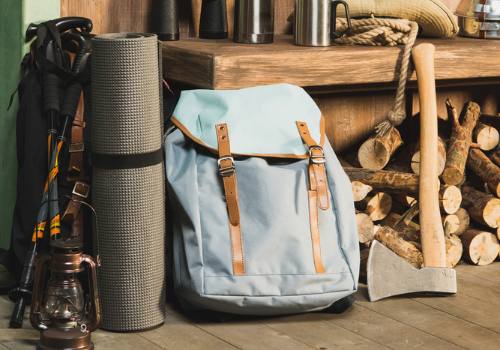
Category: Protect Your Plumbing
Two different things can happen when you connect your RV to a campground’s water supply (a.k.a. shoreline). First, you don’t know how old their pipes are. City and county minimums have acceptable standards. Meanwhile, you don’t want sand, rust, chlorine, or other contaminants to make their way into your RV’s plumbing.
The second issue is water pressure. A significant portion of campgrounds dates back to the 1960s and 1970s. The water pressure could be too high or too low. The PEX plumbing in your RV can burst due to pressures above its tolerance. The recommended water pressure for an RV is between 40-50 psi. 80 psi isn’t too high for water pressure since the PEX pipe has a rating of 100 psi.
Freshwater Hose
You’ll notice that RV fresh water hoses, like the Camco Drinking Water Hose, are white or blue. Manufacturers do this to distinguish them from standard green water hoses. The RV hoses have a special lining inside that keeps them sanitary for drinking. When you store your hose, screw the ends together to prevent contaminants from getting inside.
While you’re connected, make sure you don’t run your water pump while connected to the city water faucet (shoreline). The water pump pulls water from your freshwater tank when you’re in a boondocking (unconnected to shore connections) situation. It’s bad to leave the water pump on in an RV. If the water pump runs without water, the diaphragm component that pumps the water will dry out and crack, becoming useless.
Water Filter
As we mentioned above, you must keep your RV’s plumbing protected. You can use the self-contained disposable charcoal Blue Camco, Green Clear2o, or White Culligan filters. If you want something more complex, there are two-stage versions where you replace the filters inside the housing.
To install the water filter, you can either attach it from the shoreline faucet or close to your RV’s city water connection. Connecting it near the tap keeps your potable drinking water hose contaminant-free. Two-stage systems either sit on the ground near the RV, or you can mount the filter inside your utility bay.
Brass Hose Elbow
Many RV city water connections are vertical. When you connect your drinking water hose, the hose develops folds that hinder the water flow. Using a hose elbow allows the hose to lay naturally. It’s one of those situations where a “50 cent part solves a 50 dollar problem” (the part retails between $4-$8)
Water Pressure Gauge
Earlier, we talked about why a water pressure regulator is necessary for RVs. Non-adjustable water pressure regulators are small brass cylinders attached between the end of your water hose and the campground faucet. The device is preset for 60 psi regardless of the actual water pressure situation.
If you’re camping in a low-water-pressure campground, you can increase your water pressure with an adjustable water pressure regulator. These devices come with a readable gauge, similar to the speedometer on your vehicle. There’s a control knob on the device that adjusts the water pressure.
Sewer Hose and Attachments
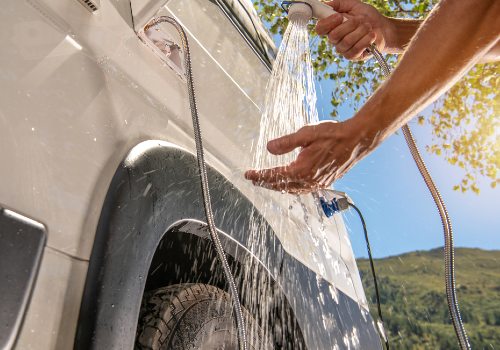
Since you’ve bought your RV, you probably figured out that new RVs don’t come with sewer hoses. Spend the extra money on the thicker casing version. Even though you should replace it every 6-9 months, you don’t want a Robin Williams sewer hose experience because something punctured the plastic.
A common question for RV beginners relates to whether they should leave their grey water tank open while camping. It’s important to note that a full tank can generate sufficient water flow due to its weight. Additionally, it’s recommended to cycle your tanks every 4-6 days. To ensure a secure connection with the campground’s sewer pipe, use the appropriate attachments for sealing, and remember to cap the hose when storing it.
Sewer Gloves
There are two schools of thought when working with your sewer hose. Some like to use thick rubber gloves. Others choose disposable latex gloves. If you go with the latex gloves, look for the corrugated grip pattern on the hand side. When you’re done working with the sewer hose, have a bottle of hand sanitizer in the utility bay to clean your hands, wrists, and forearms.
Toilet Treatment
RV toilet treatment contains agents that break down solid materials inside your black sewer tank. The blue chemical version contains formaldehyde. The formaldehyde is so powerful that it can corrode your black tank and septic tanks. The bio-enzyme version is safe for septic systems, is eco-friendly, and works well.
Whether you choose the powder, packets, or liquid form, the treatment also acts as a deodorizer with various scents, keeping the sewer smell out of your RV. If you run out of toilet treatment, the enzymes build up over time, even after you cycle the tank. Never put bleach in an RV black water tank. You’ll kill the enzymes and may damage the sensors.
RV Toilet Paper
RV toilet paper is necessary because toilet treatment agents can’t break down regular toilet paper. Residential TP can clog your sewer pipe, creating a mess. RV toilet paper does come in two-ply, so even those cartoon bears on the TV commercials will enjoy using it. Scotts Brand and other small companies produce quality products.
Category: Electric
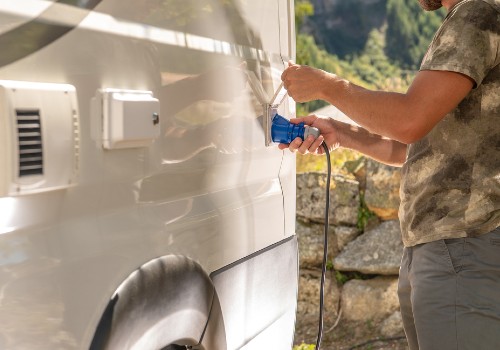
Like water, you want to protect your RV’s electric system. Surges, high currents, and low currents can be destructive. When you plug your RV into the campground’s shore power box, you want to switch the breaker inside their box to the “OFF” position. Turn the breaker on after you’re connected. This method prevents sparking or other dangerous problems.
Extension Cords
It’s good to have an extension cord that’s suited for your RV’s amperage. If you’re not sure, your shore power cord is either a three-pronged 30-amp or a four-prong 50-amp.
Surge Protector
A must-have RV feature is a surge protector. Having the device between the campground’s power box and your RV’s shore power cord creates a safety barrier. The best surge protectors for RVs are weather-resistant, have power source testing features, and are available at 30 or 50 amps.
Adapters
Sometimes, you may run into a situation where the campground has a 30 amp outlet but not a 50 amp. Having a set of adapters that allow you to plug into different amp connections is a smart choice. When you use an adapter (a.k.a. Dogbone), you need to know how to use your electrical feature correctly.
When you plug a 50 amp into a 30 amp RV adapter, you’ll have to limit your power usage. The shore power will only supply 30 amp service. If you try to pull more power, the breakers will pop to protect the campground’s circuitry. On the other hand, if you’re plugging your 30 amp RV into a 50 amp outlet, you’ll have full use of your RV electric components.
Fuse Kit
If you look inside your RV’s fuse box, you’ll see breakers (the black toggle switches) and fuses (the thin-colored plastic pieces). Inside the colored blade fuse, you’ll see a small “S” shaped piece of metal inside. If that particular circuit gets overloaded, that metal piece breaks (or pops) to protect the wiring.
These automotive blade fuses come in kits. Each color represents a different level ranging from 5-35 amps. When you replace one, make sure you’re using the same color and size. It’s also a good idea to disconnect from shore power and your house batteries to prevent injury.
Category: Stability
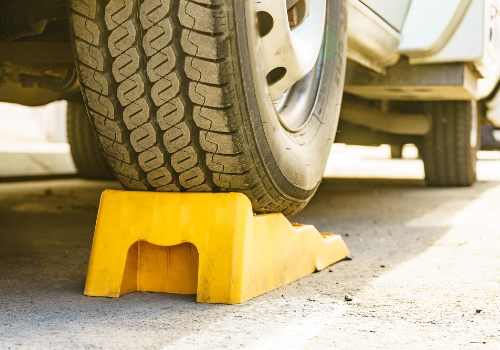
To prepare for your first RV trip, you need the right equipment to keep your RV level and locked in place. There are components, like your refrigerator, that need to stay level to operate efficiently. You also need to make sure your coach won’t roll even slightly (it does happen).
Jack Pads
Products like Tri-Lynx RV leveling blocks can be placed under your RV’s tires to raise one side of your coach. Their Lego®-like design allows you to build them up if you need to increase your RV to higher than one level. The pads give a flat surface for your stabilizer jacks.
Wheel Chocks
Placing wheel chocks on the outside of your RV’s tires keep the coach from moving. The best chocks connect to jack pads, adding to the RV’s stability. The bottom of the gadget has a gripping texture that holds it in place. If you have a dual or triple axle, you place the chocks on the outside of the outer wheels, not in between them.
Bubble Levels
An RV must have a leveling device. Whether it’s the LevelMate Pro or simple bubble level stickers, you want something to help you determine your RV’s leveling. Placing liquid-filled bubble levels on the exterior corners of your RV will give you accurate readings. Electronic versions connect via Bluetooth to your phone, giving you precise results.
Category: Safety and Service Kits
When stocking a camper trailer, having your kits equipped is vital for those bad luck moments. You want to prepare for anything that could go wrong for your peace of mind and basic needs.
First Aid Kit
Pre-packaged first aid kits don’t always have everything you need. Look on the back to see what they contain. Common injuries include burns, poison ivy, animal bites, allergies, and food poisoning. Picking up a first aid manual with detailed instructions is also a good idea.
Roadside Kit
If you break down on the side of the road, you want to do everything you can to alert others that you need help. Use semi-truck roadside equipment like orange triangles, flairs, and other items. Set your hazards up starting at least 50 yards away to warn drivers you’re on the side of the road.
Survival Kit
There are situations where RVers have broken down in remote locations—having a storage bin with bottled water, non-perishable food, blankets, and other survival gear is how to make the best of a bad situation. Even with modern telecommunications, it could take days to find you. Have campfire starting items and a multi-tool knife, too.
Tool Kit
Friends and family that want to buy gifts for RV owners should start down the tool department. Besides standard hand tools like screwdrivers, hammers, and wrenches, many RV necessities require specialized tools. Focus on repairing wood, plumbing, HVAC, and electric wiring. Wire strippers, cutters, and socket sets are a must. Like Macgyver (Original), Duct Tape is your best friend.
Category: Interior
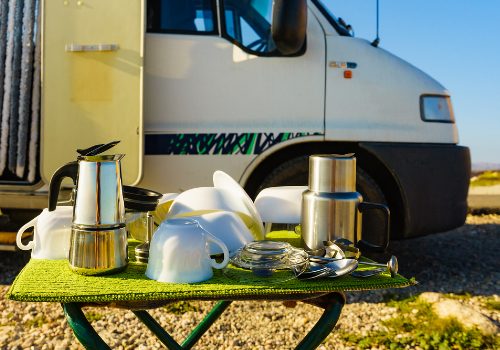
Some new to the RV world bring their residential accessories with them when they head out on the road. We recommend having separate RV interior products to avoid forgetting anything and using items to handle the trip better.
Pet Supplies
If your dog is a messy eater, there are dog bowls with high collars. Travel kennels make the trip safe for your pets, and having enough toys will help them settle their nerves. Don’t forget their vet and license paperwork since many campgrounds will want to see proof they’re up to date.
Kitchenware
Want to Connect With a Community of Over 1,078 RV Enthusiasts?
Plastic and stoneware are RV kitchen must-haves. Melamine dishes are light and shatter-proof. Make sure you bring microwave-safe dishes with you since melamine doesn’t like microwaves. RVers like to use cast-iron pans since they’re easy to clean and can be used over a campfire.
Linens
You’ll want to buy separate sheets for your RV mattresses. RV mattress sizes differ from their residential counterparts. Manufacturers have to adjust bed sizes to make room for other components in the coach.
Cleaning and Maintenance Supplies
Many household cleaning products work on your RV surfaces. Clear silicone caulk repairs seals during preventive maintenance inspections. Avoid household drain cleaners since they’re too corrosive for your RV drains. Baking powder and vinegar usually do the trick.
Category: Electronics
The must-have travel trailer upgrades many look forward to are the electronics. Why settle for a 20-inch TV when a 32-inch TV works just as well? Before you go nuts at the electronics store, do your research. Not all electronics are created equally.
Backup Camera
As of 2018, all new drivable vehicles must have backup cameras. Motorhomes have had these cameras for decades. The law doesn’t include towables yet, but backup cameras make towing and maneuvering easier. The RV industry has stepped up by adding prewiring and brackets for backup cameras on their towables. Higher-end models even have side camera prep, too.
Data Equipment
Some RV manufacturers, like Forest River, pre-install wifi routers in their coaches. RVers either use data hotspot devices through their mobile device carrier or satellite carrier network. Companies like We Boost or Winegard sells signal boosters that increase weak signals.
LED TV and Mounts
Many RVs don’t come with LED TVs. Choose mounting arms that lock in place so your TV doesn’t move around when you’re traveling. SmartTVs avoid having to add special equipment inputs. Electronics companies make RV-friendly LED TVs that work on DC power instead of AC and outdoor capable versions.
Category: Exterior
Don’t neglect the space underneath your awning. RV manufacturers have spent a lot of time and effort continually developing your coach’s door side to act as a porch-like area. You’ll also want to look into some dry camping (boondocking) equipment too.
Generator
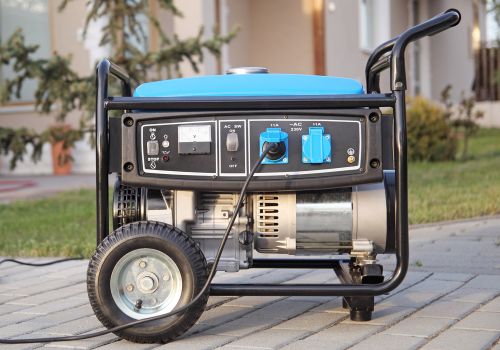
Gas or propane-powered generators are handy when you need off-grid electricity. While gas-powered generators are the most efficient, you can plug your RV into them directly (50 amps need two and a bridge adapter). Solar generators are best for individual devices like laptops, microwaves, and other plug-in electronics.
Outdoor Mat
An outdoor way is a beautiful way to welcome people to your campsite. It’s also an excellent way to keep the dirt outside by having a buffer zone between nature and your RV floors.
Outdoor Furniture
Outdoor furniture has evolved significantly from the plastic and aluminum folding chairs of the 1980s. Today, whether you’re looking to relax with your feet up, sink into a plush cushion, or enjoy the ultimate outdoor lounging experience with various additional features, there’s a chair designed to meet those needs. Beyond chairs, the range includes tables and whimsical gnomes, and no outdoor space is truly complete without the addition of a hammock or the iconic pink flamingos.
Outdoor Cooking Device
Whether you have a travel trailer with an outdoor kitchen or not, most RVs with propane tanks come with a quick connect port to connect your barbecue or other cooking devices. Today’s motorhomes and travel trailers use propane for cooking and the built-in furnace. Your 20 to 30-pound tank has plenty of fuel to grill up that freshly caught salmon you fought this morning.
What’s That Burnt Plastic Smell Coming From My Wallet?
You just spent thousands of dollars (or financed) on your dream RV. After buying a trailer, it can feel like your credit or debit card is melting from using it so much. There are many upfront costs when you enter the RV lifestyle. Minimizing your costs can be achieved by shopping around through online shopping sites and looking through Stick and Brick store websites.
Some RV discount clubs offer discounts. For example, Good Sam’s Club offers special pricing at Camping World. Your RV dealer may have special deals at their camp store for new buyers. Once you have these supplies needed for your new RV, you won’t have to repurchase them.
Now that you have all your essential accessories become an RV Trooper by continually checking in with the RV Troop website for the latest RV tips and tricks. We stay on top of the latest trends and research so you can stay on top of everything RV. If you have a question, feel free to ask it below. We value your opinion. Your question may inspire us to research our next article.
Welcome to the RV Lifestyle!
RV Accessories To Increase Your Camping Experience (Video)
"Man cannot discover new oceans unless he has the courage to lose sight of the shore."
-- Andre Gide

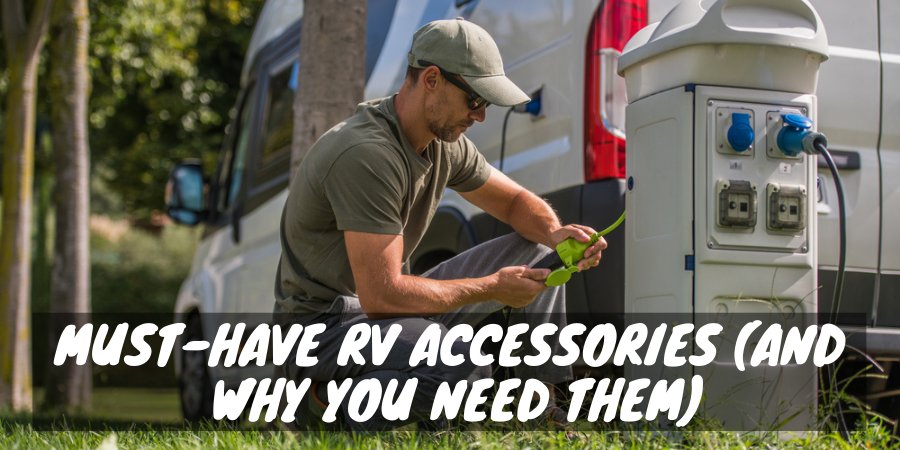
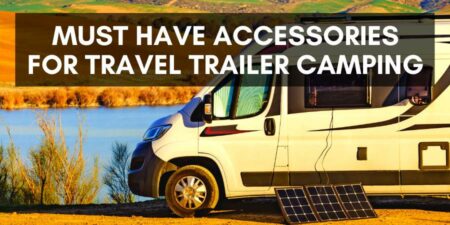
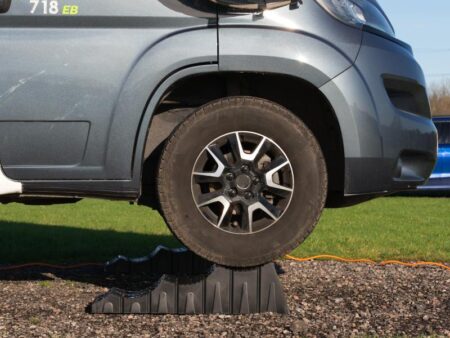
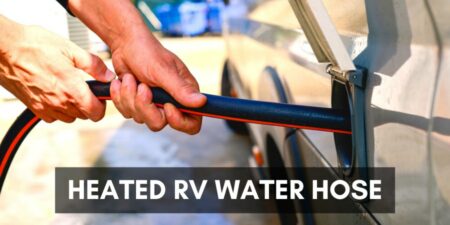







Great ideas!!